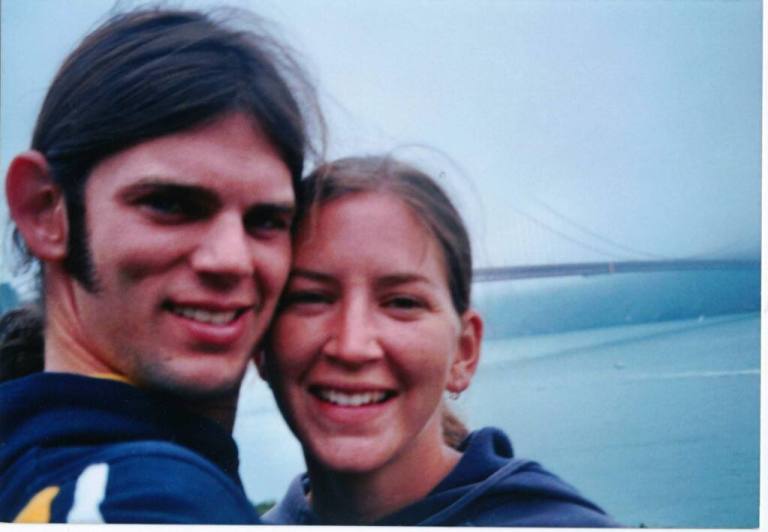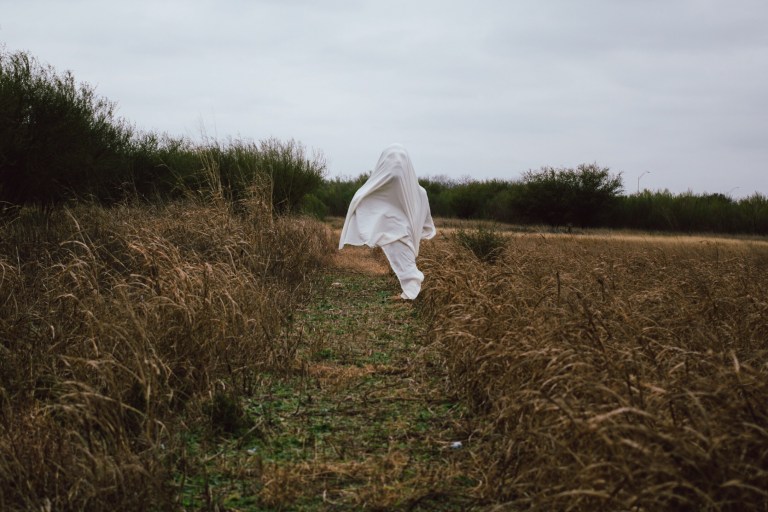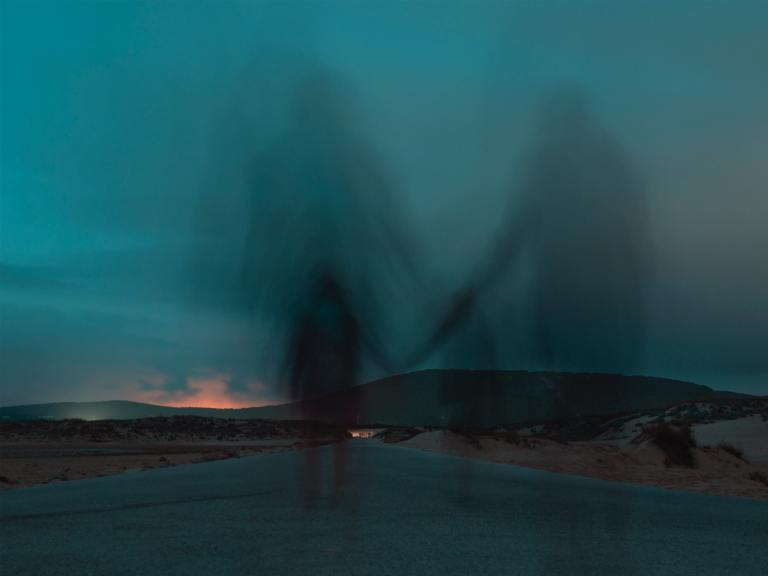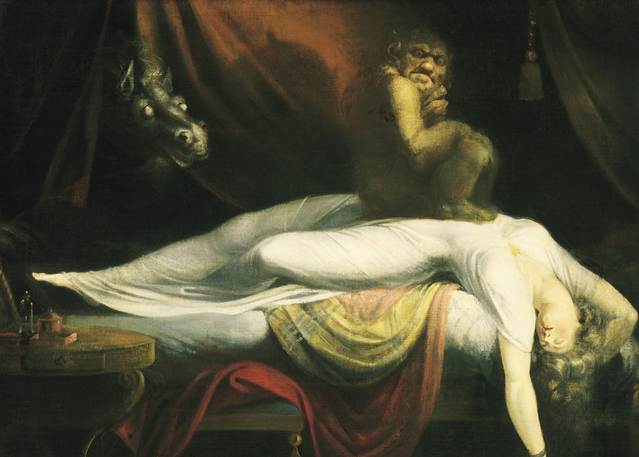
30 Facts About Sleep Paralysis To Consider While You’re Terrified, Frozen, And Unable To Scream
“Sleep is as close to death as we get.” – The Devil In The Room

1. Sleep paralysis is a phenomenon where a person wakes up but finds themselves unable to move or speak. It is commonly accompanied by feelings that something or someone is in the room with them or actually seeing or hearing something as well as a feeling of pressure on the chest and other physical sensations.
2. Sleep paralysis is not to be confused with “night terrors” where an individual will awaken and sit bolt upright in a panic, often screaming and flailing their arms wildly, unaware of their surroundings and not knowing where they are.
3. One theory on sleep paralysis is that it’s a result of REM sleep disruption where the body is still in a state of muscle atonia which prevents a dreamer from acting out their dreams. So, the body is asleep but the mind is partly awake and stuck in the surreal world of REM sleep. [Source]
4. There are two types of sleep paralysis. The first is isolated sleep paralysis or ISP. This is when an individual may experiences sleep paralysis very infrequently, possibly only once or twice in their whole lives. [Source]
5. The second kind is recurrent isolated sleep paralysis or RISP. This kind is exactly what it sounds like and an individual with this kind of sleep paralysis experiences the phenomenon is chronic and reoccur many times throughout an individuals life. [Source]
6. RISP can last up to an hour and is accompanied by a much greater chance of having an out of body experience attached to the occurrence. [Source]
7. Sleep paralysis is not common. A European study of over 8,000 people in Italy and Germany revealed that only 6.2% of the people surveyed had experienced sleep paralysis even one time. Only. .8% of those surveyed experienced sleep paralysis around once a week. 1.4% experienced it once a month and 4% experienced it once every few months. [Source]
8. Sleep paralysis does occur more among people with mental disorders but those taking anxiety medications were especially likely to experience sleep paralysis which just doesn’t seem fair, really. [Source]
9. If you sleep on your back, what I consider to be a vulnerable feeling sleep position, you’re far more likely to experience sleep paralysis and all its accompanying terrors.
Even more disturbing than the fact that there’s a sleep position that seems to facilitate sleep paralysis like some kind of malevolent magic trick is that attempting to stay out of this position doesn’t really work. For those who experience repeated occurrences of sleep paralysis, most report that they find themselves sleeping in this position anyway. [Source]
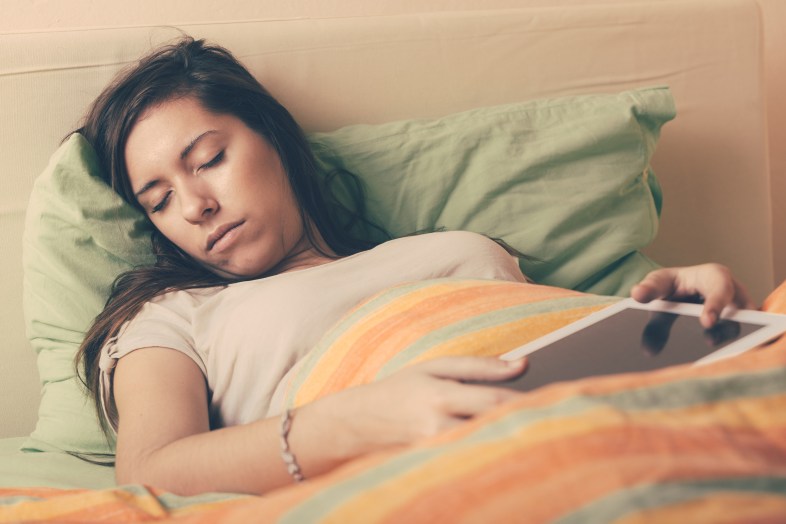
10. The experience of sleep paralysis for most is overwhelmingly negative and malevolent. One explanation is that the mind registers unexplainable events as threats as an evolutionary adaptation to keep you from acting out your dreams. Regardless, the results are horrifying as these stories show. Here’s a few of them.
11. Before I learned to cope with it I’ve seen quite a few awful things. Horror films don’t really do anything for me anymore because I’ve already seen the most terrifying things I already could. Here’s a few things I remember off the top of my head:
A little girl in the corner of my room staring at me. Then, without notice, she shrieks and runs up and starts choking me.
A large dark figure, kind of a human silhouette, emerging from the foot of my bed and staring down at me.
Something banging and scraping on my bedroom door. I keep it locked at night because I have had ones where it opens by itself. EDIT: No, the door isn’t open when I wake up. It only opens in the dream.
My bedroom door opening by itself followed by dark figures coming into my room.
The earliest one I can remember is with my mother in the room and she’s sitting on my bed, her face morphs into a demon like thing.
Many others.
The worst thing is when you try to fight or call for help. Your voice doesn’t work and your body will not respond. You just feel helpless. Ugh, I need to stop trying to remember these things. I’m getting chills. [Source]
12. I’ve gotten mine so frequently that I don’t even freak out about it anymore. It’s still scary, but not nearly as much as it used to be. The first few hallucinations were awful:
A little creature eating something on my floor. I blink. Now he’s right next to my face chewing on something and whispers “Remember me?”
An old lady standing over my head and whispers “Darling…” I told my mom about that one and she asked if I thought it was my late grandma? No. It was evil.
The hallucinations are always evil. Even if I can’t see anything, there is an overwhelming presence in the room and it is always evil. I can’t move. I’m stuck. The evil is pulling on me deeper and deeper. I can’t cry for help. I can only breath heavily as fast as I can. Hoping someone will hear me breathing so loud and will come shake me out of it. I try and move a finger. Come on finger! Why won’t you just move?! It’s going to get me! [Source]
13. One night as I was trying to fall asleep, my arm fell through the bed. Obviously my physical arm was still laying on the bed. Usually when this happens I just pick my arm up, but this time I got curious. How long would it last? So I started waiving my arm around, and my shoulder sliped through. This was new, and exiting. I moved my fingers around, swung my arm around some more, and got bold.
I consciously attempted to push my head through the bed. It worked. But, what I saw was nothing. I don’t mean I couldn’t see, but it was as if something was in fact nothing in this place. I must sound totally bonkers right now.
I could feel, though, that there was something. Farther away. My fear being exactly zero at this point, and my curiosity impossible to control, I threw caution to the wind, and tried to reach out as far as I could for whatever it was I could feel out there.
Big mistake. My leg slipped. The rest of my torso sliped. My other arm slipped, and my hips started to fall in. A the very last momment, when my left leg was all that was attached, and it was about to go, I realized somehow that what I was reaching for was NOT a thing I wanted to interact with. There was fear. Of an intensity equal to my rage during sleep paralysis. Fear like I’ve never experienced. At this point I tried to pull back but there was nothing I could do. I tried to swing my leg back up to smash into my body, but it was stretched down. like being pulled into a void. My other knee slipped, nothing but my foot ankle down and part of my left hip holding me up at this point.
I was pretty sure I was about to be gone. Whatever that means.
Just at that last second, something reached in, grabbed my shoulder and yanked me back up. Like it was nothing. I can’t really explain this properly either. The hand felt solid. Powerful. Like I was in it’s natural habitat. It pulled me back up with all the difficulty of lifting a cotton ball. I slammed back into my body with a feeling of finality. As if to say, “No fucking way I’m letting you fall into THAT”. [Source]
14. However, some experiences aren’t malevolent. Some, a very few, are pleasant. Consider this account.
15. My mom once told me that when she was younger, her room lit up and a couple of men dressed in white and gold were sitting at the foot of her bed playing music. One had a guitar and the other some kind of wind instrument. My mom said she felt such joy and peace, that she didn’t want them to ever go. But when she finally managed to move her head, she heard one say to the other, “She is waking up. It’s time for us to go.” Then they vanished. [Source]
16. Some speculate that sleep paralysis is the explanation for why some individuals believe they’ve been abducted by aliens who seemingly materialize in their room despite doors and windows being locked. One study states that the form of the “intruders” so common during sleep paralysis episodes are determined by “personally plausible cultural narratives” used to explain “otherwise baffling sleep paralysis episodes.” [Source]
17. If the above is true and we form these hallucinations out of cultural narratives then it would explain what many believe to be depictions of demons sitting on the chests of sleeping victims in art like so.
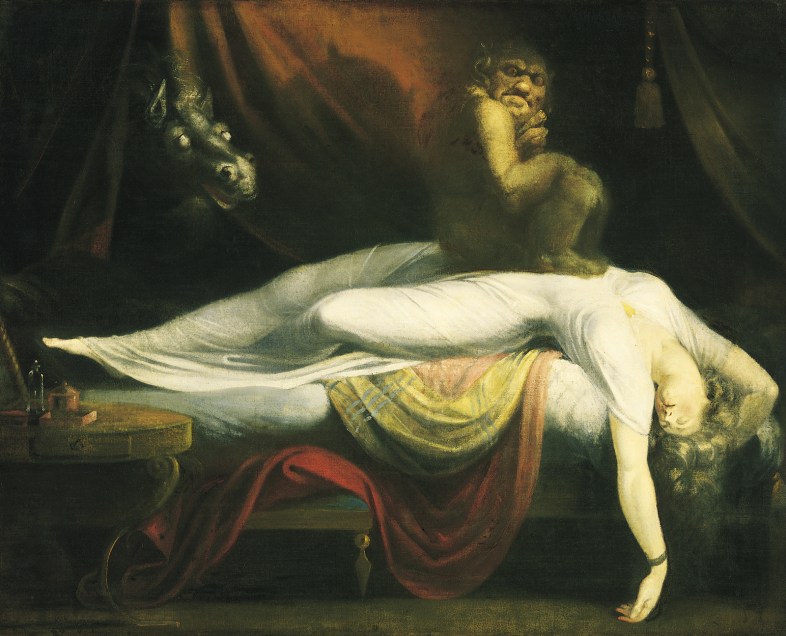
And like so.
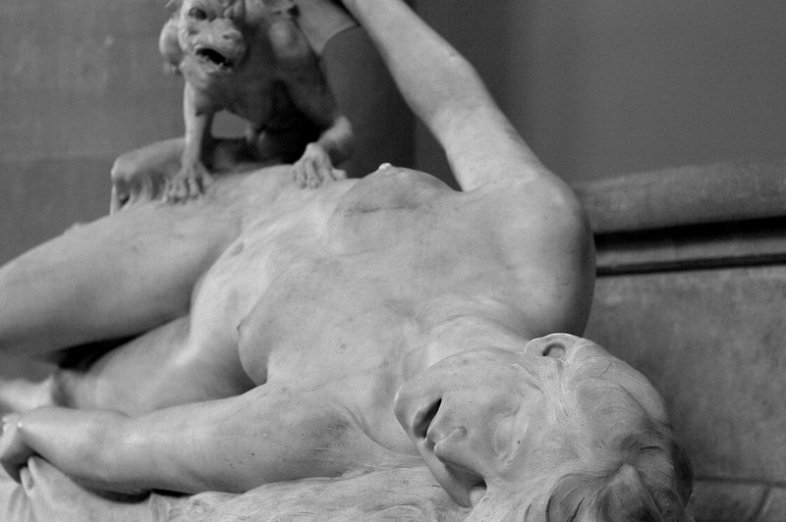
But it doesn’t tell us why so many have experiences of amorphous malevolent figures during these experiences. [Source]
18. I don’t consider any of the sources on this page or that I’ve read to adequately explain why sleep paralysis is overwhelmingly negative and scary. The “evolutionary adaptation” explanation appears to be pure conjecture and theory which, while internally logical, can’t be tested at all. Description of an event is not explanation of an event. What’s more, even scientists and experts don’t consider the phenomenon to be “explained.”
19. Some scientists in the 1940s believed waking up to be a time of sexual arousal (think morning wood) and that, therefore, sleep paralysis might be indicative of fighting against latent homosexuality. The idea here was that the paralyzed individual is fighting their natural urge to be gay when they wake up or think about being attracted to other men, etc. [Source]
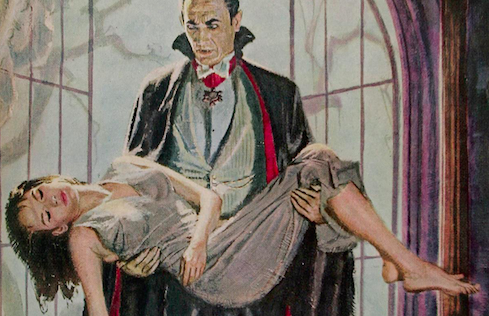
20. Does the idea of vamprirism, specifically Dracula bending over the bed of a paralyzed and enchanted victim not sound like it had its genesis in a sleep paralysis episode? Some believe these stories and others came directly from the experience of sleep paralysis. [Source]
21. Today, the word ‘nightmare’ is associated with a simple bad dream. But that’s not what nightmare used to mean. One hundred fifty years ago, It meant ‘night-fiend’ or ‘night incubus’ (or succubus as the case may be). It literally referred to entities that would come into your bedroom, sit on your chest, paralyze you, and crush the breath out of you. In short, nightmare used to mean sleep paralysis, not a bad dream. [Source]
22. Dream expert Robert Moss describes one sleep paralysis incident that was both horrifying and disturbingly sexual where a hag appeared to him in his sleep and he couldn’t move.
“Despite my disgust, I am aroused and now she is riding me. Her teeth are like daggers. My chest is spattered by blood and foulness from the rotting heads. There is nothing for me to do but stay with this. I tell myself I will survive. At last, the act is done. Satisfied, the nightmare hag transforms into a beautiful young woman. She smells like jasmine, like sandalwood. She takes me by the hand to a forest shrine. I forget about the body I have left frozen in the bed.” [Source]
23. There’s a whole theme in horror fiction based around this very notion of a demon, fair or foul, appearing in the night and essentially raping their victim. [Source]
24. Sleep paralysis, of course, spans the globe. Reports of what people see during these episodes are consistent in that nearly all include a humanoid intruder. The phenomenon is not culturally dependent. [Source]
25. And finally, one study conducted in 2014 indicates that among those who experienced this humanoid bedroom intruder, those that were afraid of it tended to have longer periods of sleep paralysis than those that didn’t. In other words, being afraid only made it worse and made it last longer. [Source]
26. Here’s the story of how one man with a history of sleep paralysis episodes managed to stop his sleep paralysis as it was happening:
“I woke up in the middle of the night, to find myself in a strange position with my arms crossed on top of my body, almost like you see with medieval carvings of knights on tombs. And I could literally feel strong hands pinning me down by my wrists.
I have to admit I was immediately scared. The whole event was very blurry, and I think I was having some dream-overlap, but can’t remember exactly what now.
“Anyway, luckily two things sprung to mind after a brief moment of panic: ‘stay calm’, I said to myself, and ‘wiggle a finger’.
The calmness I managed with moderate success, perhaps because this was the first episode in a long time, so I was caught out by it. But I did manage to focus my efforts on wiggling a finger. For some reason, despite trying to wiggle just one finger, it seemed like my body wanted to try and wiggle all of them.
In the haze of the night and the moment, it felt pretty odd, like my fingers were wiggling in different directions. But I guess that’s possibly due to the disconnect between by body and brain with the paralysis.
Eventually I felt my arms loosen as well, and then pretty soon afterwards I was able to shake the whole sensation away as I regained full control.
What I then did I still think is a little strange. Despite having the overwhelming feeling that something had physcially held me down, I decided not to turn a light on to reassure myself.
I spend so much of my time reading and replying to comments on this article, that I believe the scientific explanation is so firmly engrained in my mind, that I didn’t feel the need to ‘double-check’ that were wasn’t somebody or something in the room with me.
Instead I spent a few minutes doing some breathing exercises to ground myself and calm down. And then fell asleep again.
The mere fact that I knew about the finger wiggling technique was enough for my brain to remember to do it when the sleep paralysis occurred.
So my recommendation, from personal experience, is to plant that thought in your mind too!” [Source]
27. There are a number of specific demons or creatures from all over the world whose aspects directly match the symptoms of sleep paralysis. One is the Alp that originates from German folklore and which is described as being a small demon-like creature that wears a hat. Alps are male and they usually visit women in their sleep.
The Alp will sit on a victims chest, slowly crushing down on them until they’re unable to move and have difficulty breathing. They’re also described as drinking blood from the victim’s nipples. They’re also able to shapeshift and become invisible due to the magic in their hats. [Source]
28. The female version of the Alp is the Mare which behaves in much the same way. However, the Mare also rides horses and can even ride trees. During sleep, Mares are described as “riding” their victims.
The Mare is how we got our name for ‘nightmare’ which, again, traditionally seemed to refer to sleep paralysis and not simply bad dreams. [Source]
29. Another creature of legend is the Old Hag who comes into the victims room, sits on their chest, and sometimes steals their breath. Clearly, this creature is derived from old tales of witches. Some refer to sleep paralysis as “Old Hag Syndrome.” [Source]
30. It’s possible that all the legends about sex demons like the succubus and incubus as well as others have their origins in the malevolent experience of sleep paralysis and since people had no way to explain the phenomenon they went with what they knew, the supernatural. Combined with our ancestors natural fear of the dark, it’s fascinating to consider that this one phenomenon might be responsible for nearly all our modern day stories about shape shifters, vampires, and other demons of the night.
Below is a fantastic and quite short documentary ‘Devil In The Room’ about this very idea. It’s a good one and I recommend giving it a watch if you’re more interested in the mythic aspects of sleep paralysis. ![]()
[vimeo 68638523 w=500 h=281]
Devil In The Room from Mackinnonworks on Vimeo.
